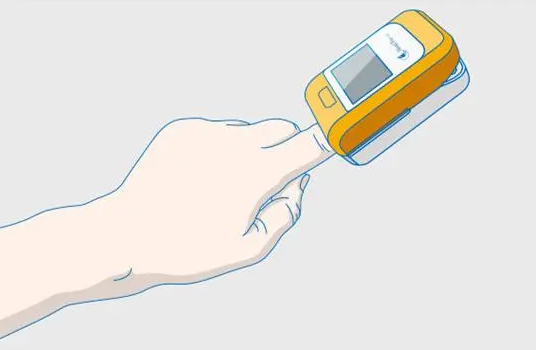In a hospital setting, arterial blood can be directly collected for accurate measurement of arterial oxygen saturation (SaO2) through blood gas analysis. However, this method requires drawing arterial blood each time, which can be intimidating. In most cases, healthcare professionals simply attach a small device called a “pulse oximeter” to the finger to obtain the reading.
The principle behind a pulse oximeter is quite simple. Our fingernails and toenails are transparent and filled with capillaries, making them ideal measurement sites. Inside the pulse oximeter, there are two light-emitting diodes (LEDs): one emits red light (660nm) and the other emits infrared light (910nm). At the other end, there is a sensor that receives the light. Oxygenated hemoglobin and deoxygenated hemoglobin have different absorption rates for these two wavelengths. By analyzing this difference, the pulse oximeter calculates the ratio of the two types of hemoglobin and estimates the pulse oxygen saturation (SpO2). The normal range is between 95-100%.
Doctors use a pulse oximeter to continuously or intermittently monitor blood oxygen saturation when they suspect a patient may be experiencing hypoxia (oxygen deficiency). If the reading falls below 95%, it indicates varying degrees of hypoxia. In such cases, further confirmation is needed through arterial blood gas analysis. Common respiratory system diseases such as pneumonia and acute laryngitis can cause a decrease in blood oxygen saturation. Various oxygen therapy methods are used to improve the condition. Additionally, cardiovascular diseases (congenital heart disease) and blood disorders (leukemia, aplastic anemia) can also lead to hypoxia.
When using a finger clip pulse oximeter, it is important to be in a calm state, keep the finger warm and relaxed, and wait for about 10 seconds until the reading stabilizes before recording it.
Avoid the following situations:
Do not have long nails, apply nail polish, or use nail stickers.
Clean the finger to remove any dirt before using the pulse oximeter, and keep the probe clean.
Avoid using the pulse oximeter on a child while they are breastfeeding or crying.
Avoid using the pulse oximeter during intense physical activity.

In conclusion, the pulse oximeter is a simple and convenient method to monitor the degree of hypoxia in the human body. If there are elderly individuals with weak health at home, it serves as a “first responder” to detect whether the body is experiencing hypoxia.